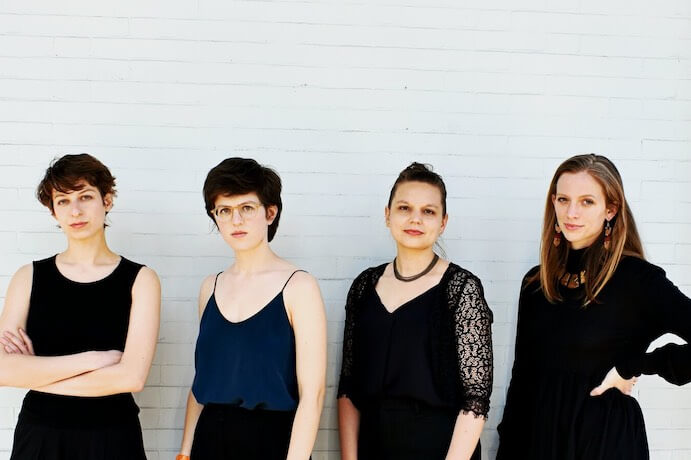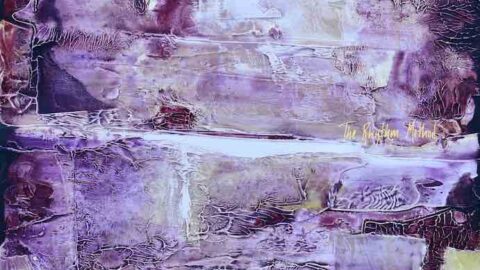You may know The Rhythm Method from Hidden Mothers, their initiative that brings the music of historic female composers into view through research, recording, and performance. Or maybe their miniFest called Broad Statements, which celebrates the breadth and diversity of creative music-making by women, non-binary, and gender-expansive people. No matter the project, The Rhythm Method questions the story told by our inherited history and challenges us to continuously consider the voices of who we create history with.
Leah Asher (violin), Marina Kifferstein (violin), Carrie Frey (viola), and Meaghan Burke (cello) have built a home at the crossroads of contemporary classical string quartet and indie band. Given that a large part of the quartet’s work is with composers from outside the ensemble, it is somewhat surprising that their eponymous debut album, out March 11, 2022 on Gold Bolus Recordings, is all work by its own members. However, the result is a powerful statement piece, both in aesthetic and design. That each member of The Rhythm Method uses her instrument and also her voice in these pieces is no coincidence. This work is grounded in the body, and in turn highlights just how often the body is absent in contemporary classical performance. The album showcases The Rhythm Method not just as virtuosic and heartfelt players, but as a group of individuals with distinct compositional voices and a collective vision for the future of the string quartet.

The album begins with Leah Asher’s work Under the Guise, which uses texture, transformation, and variation to generate momentum. The piece is chock full of glistening tremolos, undulating harmonies, and eerie, breathy bowing. The members of the quartet vocalize along with their playing — sometimes subtly with a timbre that blends well with the string instruments, and other times with a creaky, unsettling vocal fry. The amorphous feel to this work builds to something more structured towards the end, as the ensemble comes together to harmonize with blooming glissandi.
Between each of the big works by members of The Rhythm Method is a short group improvisation. These three pieces, called “shadows,” operate as a kind of connective tissue between the meatier works. Clocking in around three minutes, these interludes are welcome palette cleansers that dig deeper into some ideas, motives, and textures, while maintaining a degree of lightness.
Gone Back is a work in five short movements by Carrie Frey that uses harmonic material lifted from Chopin’s Prelude in C minor. At 15 minutes, this is the longest track on the album, but despite this, it never overstays its welcome. In one particularly striking moment, the quartet plays chromatic harmonies that drip down over a smoothly descending, oozing cello line. The work is an agonizingly beautiful meditation on the Romantic style that glows with a sublime warmth but is tinged with decay as resonant, full harmonies bloat before being devoured by swarming arpeggios. In this world, we are like creatures (toads, hedgehogs, slow-worms) taking refuge in a moldering compost heap — romanticism piled high.
Marina Kifferstein’s An Alien With Extraordinary Abilities is at once a vision of the vastness of the universe and of the pedantic, hyper-detailed paperwork needed for the O-1 visa referenced in the title. Obsessive, ruthless, and deafening, the work opens with a cacophony of high-pitched material that develops through repetition and variation. In one section, the quartet plays a quirky pizzicato motive behind relentless screeching, which gives way to a soft and rhythmic humming.
The final track on the album is Meaghan Burke’s Che Si Può Fare? (after Barbara Strozzi). In Strozzi’s melancholic aria (1664), the singer asks “what is to be done” when the world has no pity nor peace for our pain. Burke preserves this fatalistic sentiment by including fragments of harmonies and text from the original aria. One thread in this work is a descending motive imitated and echoed by the players. At times this music breaks off and leaves behind a void that softly echoes with hisses, whispered consonants, and suspended pizzicato harmonics.
With its final track, The Rhythm Method prompts us to ask “Che si può fare? (What is to be done?),” but they certainly offer an answer, as well. When we question our inherited history, we put the work in to shape our future; when we fully engage with our selves in our work, we forge a way forward when the world is unsympathetic.
I CARE IF YOU LISTEN is an editorially-independent program of the American Composers Forum, funded with generous donor and institutional support. Opinions expressed are solely those of the author and may not represent the views of ICIYL or ACF.
A gift to ACF helps support the work of ICIYL. For more on ACF, visit the “At ACF” section or composersforum.org.
























